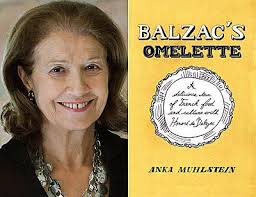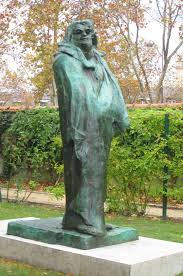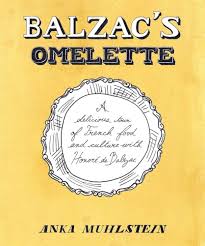Anka Mühlstein, Balzac’s Omelette (2010).
Good Reads meta-data is 231 pages, rated 3.38 by 184 litizens.
Genre: Non-fiction; Species: Gourmet.
DNA: Gallic.
Verdict: Erudite, witty, and insightful.
Tagline: What, where, and when you eat reveals your identify.

Across the panorama of La Comédie humaine, Balzac uses food to evoke character, to establish atmosphere, to reveal social class, to suggest conventions, and more. He is credited in these pages with being the first author to bring food and eating into fiction.
The timing was right for this excavator of humanity to do so. Prior to the French Revolution there were no restaurants (in our sense of the word). Dining was done at home, but the Revolution rendered unemployed ranks of chefs, pastry cooks, soup specialists, providores, butchers, gardeners, and the like who had ladened the tables of aristocracy, nobility, and royalty. From these ranks a couple of enterprising souls opened an eatery. Prior to that coffee houses, which occasionally offered bread or biscuits, table d’hôte, inns, or street vendors were the only meals available to someone away from home.*
The talkfest that the aftermath of the Revolution unleashed in Paris brought thousands of men to the capital, and they had to eat. There was the demand to be supplied by all those unemployed caterers.
The word ‘restaurant’ comes from restore, and originally the nascent restaurants offered restoratives, that is, light meals to tide one over until the evening meal. But unlike the establishments mentioned above in a restaurant, one could eat at a time of choice and select what to order and only pay for what was consumed (not a fixed price), while sitting down inside. It was a culinary revolution that quickly developed.
Balzac often describes meals but he seldom includes the menu, but rather concentrates on the manners and mores, the spectacle, the tableware, the candles, the ostentation or humility, the occasions, the aftermath, the subtexts, the verbal sparring, that is, he treats the meal as a mis-en-scene. He himself had a vexed relation with food (like everything else), while in the throes of composition to generate income to defray creditors and buy food and wine, and, oh, pay some of the arrears in rent, he did but drink coffee. He said it was fifty (50) cups a day, and ate very little, or nothing.

Then when the cheque came in he would bust loose with a gigantic feast, inviting all and sundry, and a barrel of the best Bordeaux to mark his achievement. The result of this manner of living was the corpulent character we know from cartoons, though he despised his own fat he made no systemic effort to reduce his weight except for that coffee. There is a strain of self-hatred in him that shows in his novels.
No sooner would he recover from such an excess than the knock of the bailiff would drive him into another composition.
*A table d’hôte at the time referred to to a boarding house meal, where a stranger might enter, and if a place was free, take a meal plonked down. In such a case this stranger ate what was put on the table. Paid for it whether he ate it all or not and left. The term today means a menu fixé for a fixed price. In an inn one ate at a fixed time, for a fixed price, and took what was offered. No choice. Inevitably stew of some kind.
P.S. Street food — the crèpe — was more varied and available at all hours, but of course there was nowhere to sit, and one was exposed to the elements.

